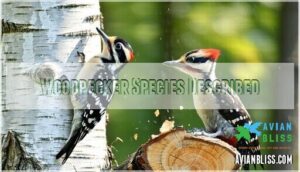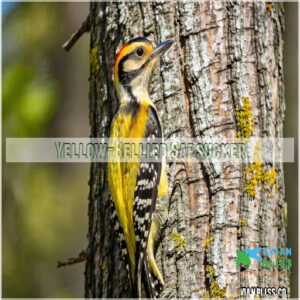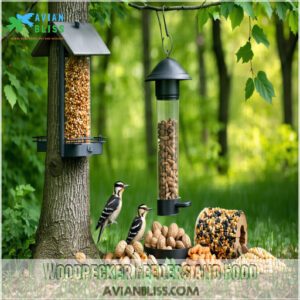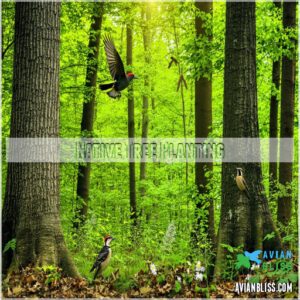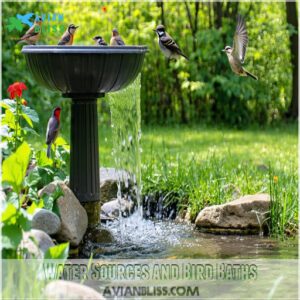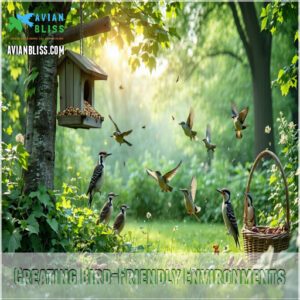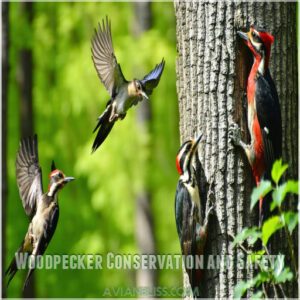This site is supported by our readers. We may earn a commission, at no cost to you, if you purchase through links.
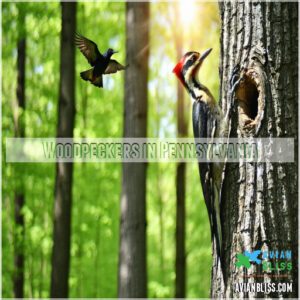 Pennsylvania’s forests are home to eight woodpecker species, offering a colorful and varied birding experience.
Pennsylvania’s forests are home to eight woodpecker species, offering a colorful and varied birding experience.
From the tiny Downy Woodpecker with its spotted wings to the large and dramatic Pileated Woodpecker, you’ll find a range of unique feather patterns and behaviors.
Keep your eyes peeled for the Red-bellied, Hairy, and Yellow-bellied Sapsucker woodpeckers, too.
Each species has its own preferences, so you’re likely to spot different ones depending on where you are in the state.
But no matter where you wander in Pennsylvania’s woodlands, you’re never far from the rhythmic drumming of these fascinating birds.
Stay tuned to learn more about these vibrant forest dwellers.
Table Of Contents
- Key Takeaways
- Woodpeckers in Pennsylvania
- Woodpecker Species Described
- Woodpecker Habitat and Behavior
- Attracting Woodpeckers to Yards
- Woodpecker Conservation and Safety
- Frequently Asked Questions (FAQs)
- What is the most common woodpecker in Pennsylvania?
- Is it good to have woodpeckers in your yard?
- What will keep woodpeckers away from your house?
- What’s the difference between a flicker and a red-bellied woodpecker?
- How many types of Woodpeckers are there in Pennsylvania?
- Why are there So Many woodpeckers in Pennsylvania?
- Where can I see woodpeckers in Pennsylvania?
- Are black backed woodpeckers common in Pennsylvania?
- Are there red-bellied woodpeckers in Pennsylvania?
- How do you identify woodpeckers in Pennsylvania?
- Conclusion
Key Takeaways
- Pennsylvania is home to eight woodpecker species, including the Downy, Red-bellied, Hairy, Pileated, Yellow-bellied Sapsucker, and the Northern Flicker, each with unique characteristics and behaviors.
- These birds are nature’s pest control, feeding on insects, berries, nuts, and even tree sap. They play an essential role in forest regeneration and pest control.
- Woodpeckers in Pennsylvania have diverse nesting and feeding habits. Some prefer the southeastern areas, while others are found in the Pocono Mountains or migrate seasonally.
- You can attract woodpeckers to your yard by offering a variety of food, such as suet, nuts, seeds, and fruit, as well as providing native trees for nesting and water sources.
Woodpeckers in Pennsylvania

You’ll find eight remarkable woodpecker species in Pennsylvania’s forests, from the tiny Downy Woodpecker to the crow-sized Pileated Woodpecker that inspired the cartoon character Woody Woodpecker.
Whether you’re watching them tap on trees in the Pocono Mountains or visit your backyard suet feeder, these fascinating birds will keep you entertained with their acrobatic climbing and rhythmic drumming.
Overview of Species
Pennsylvania’s woodpecker species offer a fascinating study in variety, from the tiny Downy to the massive Pileated woodpecker.
You’ll spot these remarkable birds throughout the state’s diverse landscapes, each with unique feather patterns and behaviors.
The lineup includes the common Red-bellied Woodpecker, adaptable Downy Woodpecker, robust Hairy Woodpecker, majestic Pileated Woodpecker, and the seasonal Yellow-bellied Sapsucker, making woodpecker identification an exciting challenge for Pennsylvania birding enthusiasts.
To learn more about these species and their habits, understanding woodpecker species is essential for any birdwatcher in the state.
Distribution and Frequency
Not all woodpeckers in Pennsylvania stick to the same spots.
Some, like the Downy Woodpecker, thrive across forests statewide, while the Red-bellied Woodpecker prefers southeastern areas.
You’ll find Hairy and Pileated Woodpeckers in the Pocono Mountains, while the Yellow-bellied Sapsucker migrates seasonally.
Keep an eye out—regional variations and habitat preferences make spotting these species a fun challenge!
Physical Characteristics
From bold red crests to intricate feather patterns, Pennsylvania woodpeckers are a feast for the eyes.
Downy woodpeckers sport tiny frames and spotted wings, while pileated woodpeckers wow with dramatic plumage colors and striking head markings.
Beak shapes vary too—some long and sharp, others short and stout, whether it’s their wing structure or vibrant crowns, each woodpecker species is uniquely enchanting.
Woodpecker Species Described
You’ll find Pennsylvania’s woodpeckers are as diverse as they’re fascinating, each with its own unique traits and habits.
From the tiny Downy to the striking Pileated, these species bring life to forests, parks, and even your backyard.
Red-Bellied Woodpecker
Let’s talk about the Redbellied Woodpecker, a standout among Pennsylvania woodpeckers.
Its red crown and faint red belly feathers make it unmistakable.
Known for sharp woodpecker calls and territorial nesting habits, this woodpecker species thrives in forests and suburban trees.
With a diet of nuts, berries, and suet, it’s a frequent visitor to feeders across Pennsylvania.
The Redbellied Woodpecker’s ability to excavate holes is a key example of woodpecker adaptations that enable it to thrive in various environments.
Downy Woodpecker
If the Red-Bellied Woodpecker caught your eye, wait until you spot the Downy Woodpecker.
As the smallest woodpecker in Pennsylvania, it’s a master of Small Bird Behavior.
Look for its black-and-white Feather Patterns and the male’s red crown.
- Downy Woodpecker Diet: Insects, berries, seeds, nuts.
- Woodpecker Nesting: Deadwood trees.
- Habitat: Forests, parks, suburbs.
- Woodland Ecology: Essential insect control.
Hairy Woodpecker
The Hairy Woodpecker, a year-round resident among woodpeckers in Pennsylvania, is often mistaken for its smaller cousin, the Downy.
Sporting striking black-and-white "Hairy Feathers" and a sharp bill, it’s known for its loud Woodpecker Drums echoing through forests.
Preferring Tree Cavities for Nesting Sites, this woodpecker species thrives in mature woods, snacking on insects and suet from backyard feeders.
Pileated Woodpecker
Spotting a Pileated Woodpecker feels like meeting royalty in the woods.
With their bold red crests and loud Pileated Calls, they’re the largest of the pennsylvania woodpecker species.
These forest giants love:
- Excavating Tree Cavities for nests.
- Drumming on trunks to mark territory.
- Hunting ants in fallen logs.
- Exploring Forest Canopies for beetles.
Yellow-Bellied Sapsucker
The Yellow-Bellied Sapsucker stands out among Pennsylvania birds with its bright yellow belly and knack for sap drinking.
You’ll often hear its unique woodpecker calls near tree cavities in wooded areas.
This migratory woodpecker species breeds up north but visits Pennsylvania during migration patterns.
Its nesting habits and diet of tree sap, insects, and fruit make it a fascinating addition to Pennsylvania wildlife.
The species’ behavior is characterized by its sapwell maintenance techniques, which involve drilling holes in trees to extract sap.
This unique behavior, combined with its distinctive calls and migration patterns, makes the Yellow-Bellied Sapsucker a notable species in the region.
Woodpecker Habitat and Behavior
You’ll find woodpeckers thriving in Pennsylvania’s forests, where they carve out tree cavities and forage for insects with impressive precision.
These birds are busy multitaskers, from drumming on trees to attract mates to raising chicks in cozy, bark-lined nests.
Forested Areas and Trees
Pennsylvania woodlands are a haven for woodpeckers, thriving in tree canopies and deadwood-rich areas.
These birds play a key role in forest regeneration and woodland ecosystems by controlling insects and aiding timber management.
Pileated woodpeckers, in particular, favor mature forests.
Understanding woodpecker habitats is essential for their conservation and management.
- Deadwood importance: Indispensable for nesting and foraging.
- Tree canopy: Offers shelter and food.
- Pennsylvania forests: Diverse habitats attract multiple species.
Diet and Foraging Habits
In Pennsylvania woodlands, woodpeckers thrive on an omnivorous diet.
Their insect consumption keeps pests in check, while berry feeding and nut gathering fuel them year-round.
Some, like the Yellow-bellied Sapsucker, master sap extraction, while others enjoy fruit sources from trees.
Watching a woodpecker foraging feels like nature’s grocery run—efficient, resourceful, and a little noisy!
Co-Parenting and Social Interactions
Woodpeckers in PA are all about teamwork regarding raising their young.
Many species, like the Downy and Red-bellied, practice monogamy, forming strong social bonds.
Their coparenting skills are impressive—both males and females share nesting behaviors and parental care duties.
This cooperative breeding guarantees their chicks thrive, proving that woodpecker behavior is as fascinating as their pecking skills.
Attracting Woodpeckers to Yards
If you want woodpeckers to visit your yard, you’ve got to make it irresistible for them.
With the right food, native trees, and even a splash of water, you’ll turn your backyard into a woodpecker’s paradise in no time.
Woodpecker Feeders and Food
In terms of feeding woodpeckers in PA, variety is key.
Try these options:
- Suet Feeders: Tail-prop designs work great for suet blocks.
- Nut Dispensers: Peanuts and tree nuts are favorites.
- Seed Types: Sunflower seeds and cracked corn attract them.
- Fruit Offerings: Apples, oranges, or berries.
- Sap Flow Mimics: Bark Butter spread on trees.
Using the right suet feeder types can substantially enhance the feeding experience for woodpeckers.
Keep your bird feeders clean!
Native Tree Planting
If you’re setting up feeders, why not go a step further?
Planting native trees like oaks, hickories, or maples supports forest regeneration and attracts woodpeckers common to southcentral PA.
These trees provide food, nesting spots, and balance to the ecosystem.
Proper tree selection and soil preparation guarantee success, creating a haven for Pennsylvania wildlife and enhancing woodpecker habitat naturally.
Using Native Tree Seeds is vital for maintaining biodiversity in local ecosystems.
Water Sources and Bird Baths
Adding fresh water to your yard is a game-changer for woodpeckers in PA.
Bird baths, rain barrels, or small water features attract thirsty visitors like the Downy and Red-bellied Woodpeckers.
Keep water clean to avoid harming Pennsylvania wildlife.
Bonus tip: A shallow edge or dripping feature mimics nature, boosting your bird watching Pennsylvania experience, especially with woodpeckers common to southcentral PA!
Creating Bird-Friendly Environments
After setting up water sources, think about your yard’s layout.
Plant bird-friendly plants like oak or hickory to offer food and shelter.
Native gardening supports wildlife conservation while boosting woodpecker visits.
Use eco-friendly designs—deadwood or brush piles work wonders for nesting.
Sustainable landscaping also attracts backyard birds and keeps Pennsylvania birds thriving for future bird watching adventures.
Installing the right bird feeding systems can further enhance the attractiveness of your yard to woodpeckers and other bird species.
Woodpecker Conservation and Safety
Protecting woodpeckers means keeping them safe from threats like habitat loss, disease, and human interference.
You can help by learning about their health risks, following conservation laws, and making your yard a safer space for these fascinating birds, which involves understanding and addressing human interference.
Diseases and Health Risks
Feeding and attracting woodpeckers in PA is rewarding, but don’t overlook health risks.
Bird droppings can harbor fungi causing Avian Infections like histoplasmosis.
Woodpecker parasites and pathogens, including Salmonella and roundworms, pose dangers if inhaled or ingested.
Always clean feeders and bird baths regularly to prevent disease transmission and protect both Pennsylvania birds and yourself while enjoying these wildlife visitors, which can help mitigate the risks associated with woodpecker parasites.
Histoplasmosis and West Nile Virus
Not many know woodpeckers in PA can indirectly spread diseases like histoplasmosis or West Nile Virus.
Protect yourself and these birds with these tips:
- Avoid inhaling dust near bird droppings to prevent fungal infections.
- Eliminate standing water to reduce mosquito breeding.
- Clean feeders regularly for better bird health.
- Wear gloves when handling nesting areas for wildlife safety.
Understanding common bird diseases symptoms is essential for effective woodpecker conservation and safety measures.
Preventing Disease Transmission
Keeping woodpeckers in PA healthy starts with proper sanitation methods.
Clean feeders regularly to reduce disease vectors and health risks.
Avoid overcrowding by spacing feeders and water sources.
Transmission control is key—replace old food often and clean nesting areas.
While vaccination strategies aren’t for birds, your diligence supports woodpecker conservation.
Protect their diet and habitat; they’ll thank you with lively visits, which is a result of good transmission control.
Protected Species and Regulations
Woodpeckers are feathery friends protected by law.
Before you reach for that baseball bat, check out these regulatory fun facts:
- State and Federal Laws: Woodpecker whacking is a no-no.
- Migratory Bird Treaty Act: This act from 1918 stops folks from removing migratory birds, like woodies, from their property.
- Federal Permit: Prove those birds are causing serious damage, and you might get a pass to give ’em the boot.
- Ecologically Beneficial: These birds are doing their part for nature.
- Red-Headed Woodpecker: In Pennsylvania, this particular woodpecker is on the protected list due to dwindling numbers.
But you better have records of your efforts to shoo ’em away first.
Only consider canning them as a last resort.
Frequently Asked Questions (FAQs)
What is the most common woodpecker in Pennsylvania?
Like a busy barista, the Downy Woodpecker taps out a rhythm in Pennsylvania forests.
This black-and-white bird, with its red crown, is the state’s most common woodpecker, often co-parenting and foraging for insects.
Is it good to have woodpeckers in your yard?
Having woodpeckers in your yard can be a treat.
They’re nature’s pest control, feasting on insects that may be hiding in your trees.
Plus, their vibrant colors and unique calls add a touch of wilderness to your home.
What will keep woodpeckers away from your house?
There are a few things you can try to deter woodpeckers from your house.
First, try hanging wind chimes or reflective items near areas they frequent.
You can also try applying a sticky substance, like bird gel, to their favorite perching spots.
What’s the difference between a flicker and a red-bellied woodpecker?
Besides the obvious red belly of the red-bellied woodpecker, its back is barred, and its head is gray. Flickers have brown-spotted plumage, a red nape, and gray beards.
How many types of Woodpeckers are there in Pennsylvania?
There are six main woodpecker species in Pennsylvania: Red-bellied, Downy, Hairy, Pileated, Yellow-bellied Sapsucker, and the Northern Flicker. Each has unique features and habits, adding color to the state’s forests.
Why are there So Many woodpeckers in Pennsylvania?
Pennsylvania’s diverse habitats and abundant food sources create a woodpecker wonderland.
These birds thrive in the state’s varied landscapes, from dense forests to swampy areas, offering ample nesting and feeding opportunities.
The combination of these factors makes Pennsylvania an ideal place for woodpeckers, with abundant food sources available throughout the year.
Where can I see woodpeckers in Pennsylvania?
Spotted in forests, mountains, and highlands, these birds are a common sight across Pennsylvania. Try the Pocono Mountains, Allegheny Plateau, or Laurel Highlands for a glimpse of these colorful creatures.
Are black backed woodpeckers common in Pennsylvania?
Black-backed woodpeckers are uncommon in Pennsylvania. These birds typically reside in coniferous forests across Canada and the northern US, migrating south during harsh winters.
Are there red-bellied woodpeckers in Pennsylvania?
Like a splash of paint across the landscape, the red-bellied woodpecker is indeed a resident of Pennsylvania.
With its distinct red head and pink belly, it’s a common sight in the eastern and central regions of the state.
How do you identify woodpeckers in Pennsylvania?
Here’s a quick guide to help you ID these birds:
Look for unique features like red heads, pink bellies, black-and-white spots, stripes, or a yellow belly.
Size varies, so keep an eye out for anything from tiny to large.
Conclusion
There’s more to Pennsylvania’s forests than meets the eye.
With eight unique woodpecker species, the state offers a vibrant birding experience.
From the tiny Downy Woodpecker to the dramatic Pileated Woodpecker, each species has its own charm.
Keep your eyes and ears open for these rhythmic drummers, and you’ll be treated to a colorful display of woodpeckers in Pennsylvania’s woodlands.
- https://avibirds.com/woodpeckers-of-pennsylvania/
- https://www.pa.gov/agencies/pgc/wildlife/discover-pa-wildlife/woodpeckers.html
- https://owlcation.com/stem/Woodpeckers-of-Pennsylvania-and-the-Northeast
- https://wildlifehelp.org/animals/pennsylvania/woodpecker
- https://www.animalspot.net/woodpeckers-in-us/pennsylvania-woodpeckers

